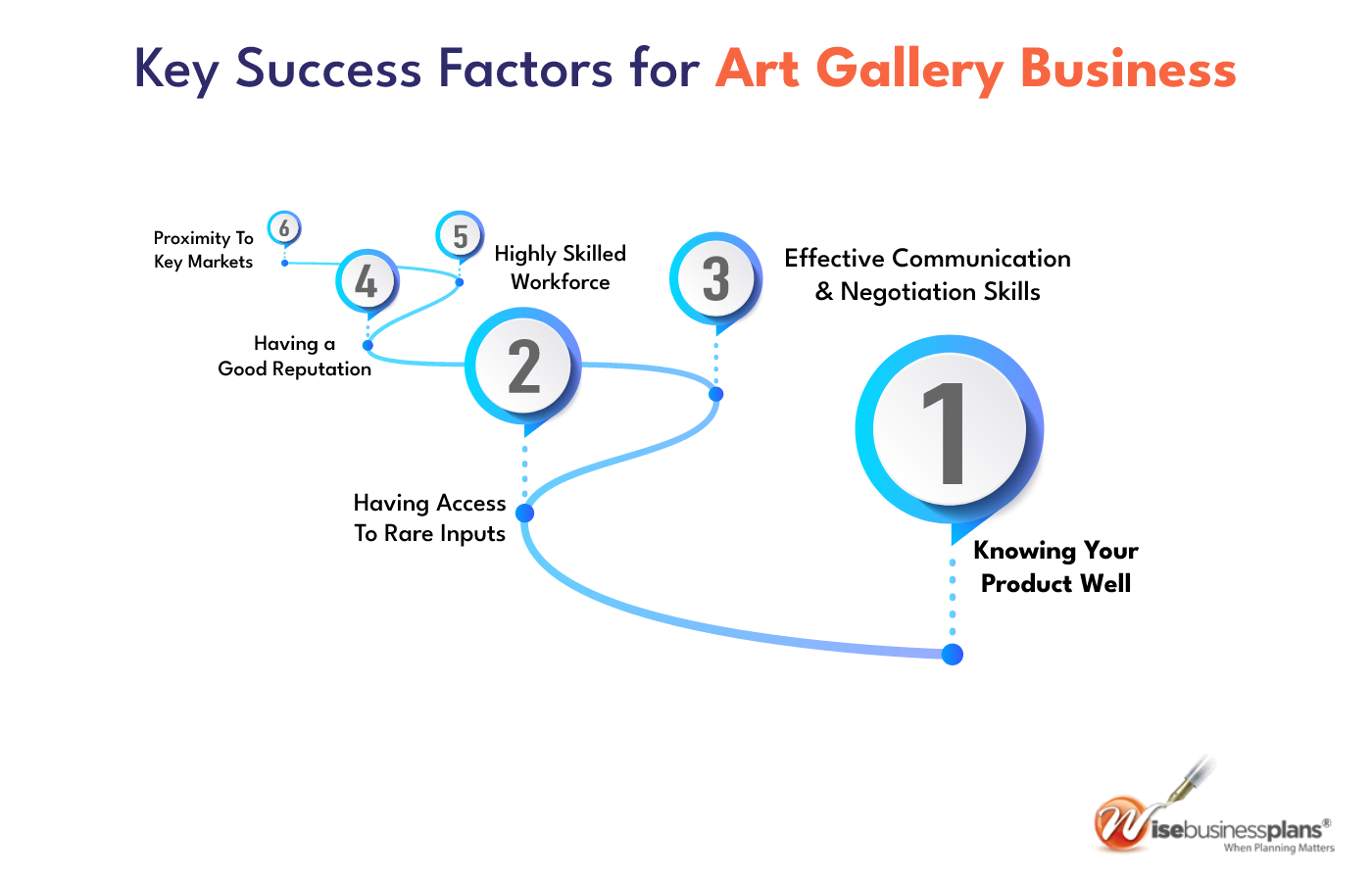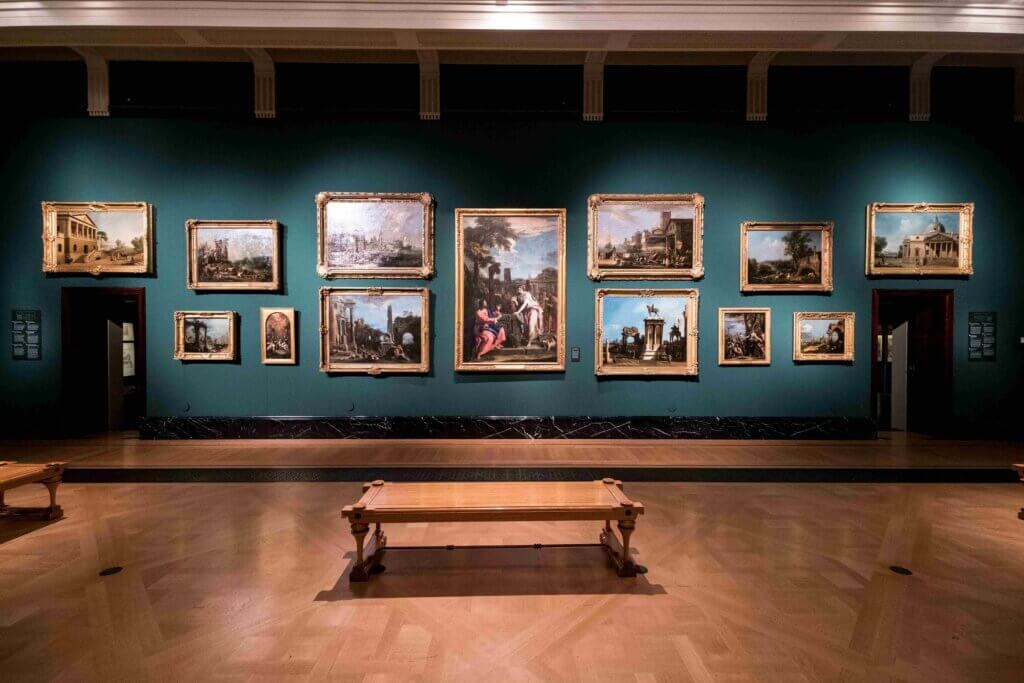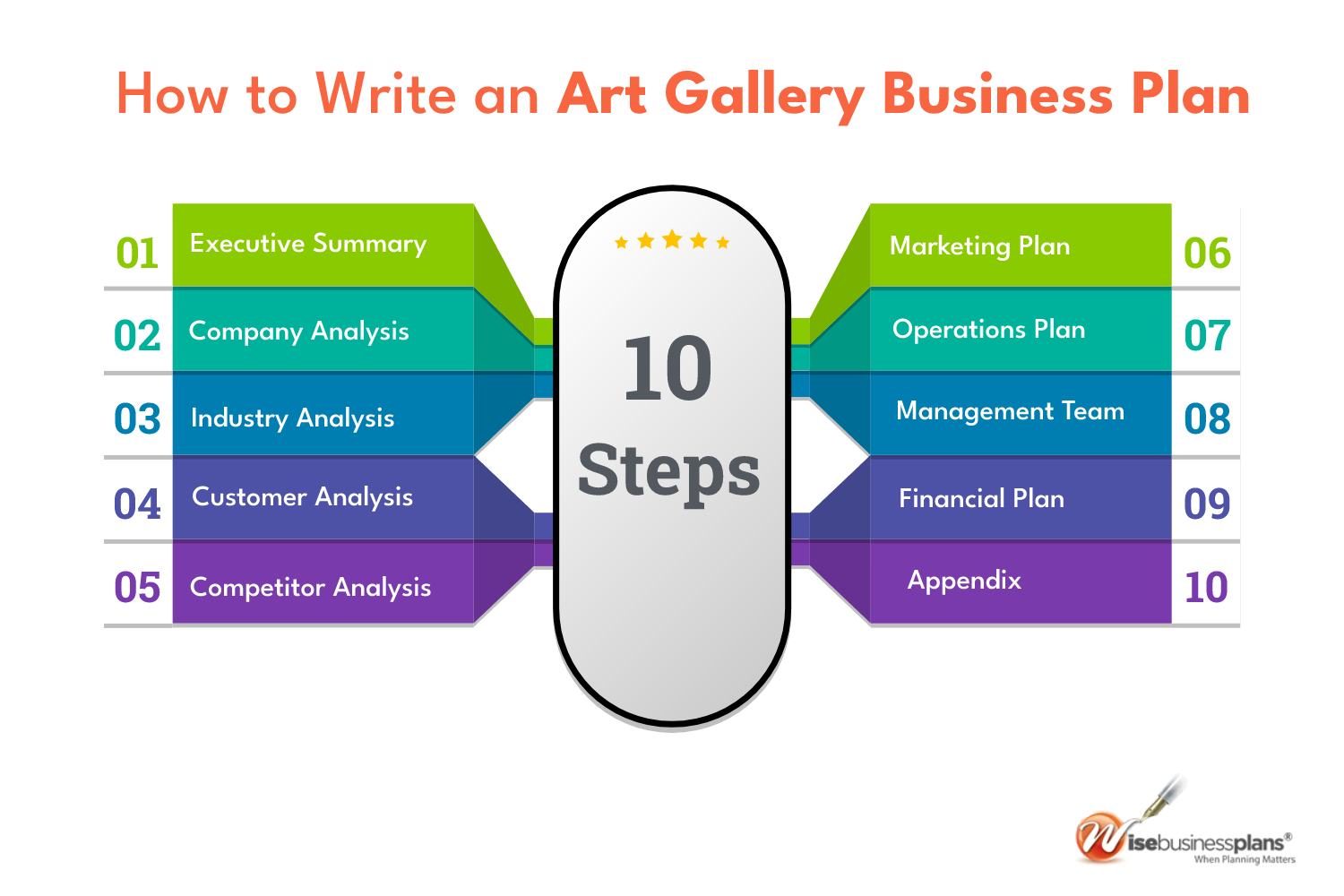Art Gallery Business Plan Template
Whether you want to start your own art gallery business or expand an existing one, you need a business plan. The following art gallery business plan template lets you know what elements you need to include in a successful art gallery business plan.
Fill the Form to Download Business Plan Templates
To ensure your art gallery business success in this highly competitive market, you need a properly structured art gallery business plan. With over 12 years of experience, we have helped over 5,000 entrepreneurs create business plans to start and grow their art gallery businesses. Using the following art gallery business template, you can put together an effective business plan for art gallery.
Things to Know Before Writing an Art Gallery Business Plan
The art industry consists primarily of art galleries and art auction houses that retail original and limited-edition artwork. Typically, the companies purchase artwork from an artist or an individual owner, and then market it to consumers, without further developing the product. Furthermore, auction houses collect commissions by bringing buyers and sellers together.
Most of the industry’s revenue is generated by large auction houses and small galleries selling affordable pieces.
The industry revenue is forecast to grow at an annualized rate of 1.8% to $11.4 billion over the 3 years to 2024. The market is expected to grow because of the popularity of contemporary art, rising disposable income, and an increase in museums seeking to entice visitors with high-priced purchases.
Among the major products and services offered in this industry are
- Paintings
- Drawings
- Prints
- Sculptures
- Photography
- Other media
Key Success Factors for the Art Gallery Business

Despite the challenges of the art gallery industry, we have identified 6 factors that can help you boost profitability, efficiency, and ultimately success.
- Knowing your product well: To resell a work of art at a profit, a dealer must be able to authenticate and price it accurately. It is essential to find undervalued works or artists who are likely to gain popularity.
- Having access to rare inputs: Access to rarely sold art is crucial for art dealers. Establishing a close relationship with an owner puts a dealer in a good position when the owner decides to sell.
- Effective communication and negotiation skills:
Since an artwork’s value is subjective (rather than based on the price of its materials), a business needs to have superior communication and negotiation skills to sell it privately or at an auction. - Having a good reputation: A good reputation and quality service are crucial to sourcing artwork from owners and artists and selling it to collectors.
- Highly skilled workforce: The process of sourcing, authenticating, valuing, cleaning, and storing artwork requires highly skilled staff.
- Proximity to key markets: It is critical to be close to major international cities, since many high-end consumers and art collectors reside in these areas. Having a tight financial grip over revenue and costs, especially debt collection and overhead, is essential for cash flow planning.
Need a Professional Business Plan Writer for Your Art Gallery Business?
What is an Art Gallery Business Plan?
An art gallery business plan is a road-map for starting and growing your art gallery business. Your business plan outlines your business concept, identifies your target customers, presents your marketing strategy, and details your financial projections.
Any bank or investor you approach will require an art gallery business plan, so putting one together will be critical to securing funding.
In short, writing a business plan can help you succeed if you’re thinking of starting an art gallery business or pitching to investors or venture capitalists.

Why You Need an Art gallery Business Plan
Art gallery business plans can be used to gain interest from potential investors or to secure loans from banks. They are also helpful to you as the owner. An art gallery business plan allows you to thoroughly analyze every aspect of your potential business.
A solid, detailed plan gives you a clear path to follow, forces you to examine the viability of an art gallery business idea, and may help you better understand your company’s finances and competition.
Art gallery business owners who have a business plan grow 35% faster than those who don’t, and 75% of fast-growing businesses have one.
An art gallery business plan is a living document that should be updated annually as your company grows and changes.

Free: Business Plan Examples
Do you need help creating a business plan? Check out these six free, proven business plan examples from different industries to help you write your own.
Sources of Art Galleries Funding
An art gallery business is mostly funded by personal savings, credit cards, bank loans, and angel investors. In terms of bank loans, banks will want to review your art gallery business plan and make sure you will be able to repay the loan and interest.
Angel investors are the second most common source of funding for an art gallery business. These are wealthy individuals who will write you a check. They may ask for equity or, like a bank, they may offer a loan. Venture capitalists are not likely to fund an art gallery business.
They may consider financing a national art gallery business, but not a single location. The reason is that most venture capitalists expect a return of millions when they make an investment, and an individual location cannot achieve such results.
How to Write an Art Gallery Business Plan

To write an art gallery business plan, you don’t need to be an expert. Our step-by-step guide will show you how to write an art gallery business plan, or you can just download our proven sample business plan pdf to get a better idea.
Executive Summary
The executive summary is the most important part of the document since it outlines the whole business plan. Despite the fact that it appears first in the plan, write the executive summary last so you may condense key concepts from the other nine parts.
It’s a part that catches the investor’s eye and provides key information about your company’s overview and upcoming short- and long-term goals.
Tell them what kind of art gallery business you have and what stage you’re in; for example, are you a startup, do you have an art gallery agency that you want to expand, or do you have a lot of art gallery businesses?
Finally, an executive summary should provide investors with a preview of what they may expect from the rest of your document.
- Provide a high-level overview of the art gallery industry
- The name, location, and mission of your art gallery business
- A description of your art gallery business, including management, advisors, and a brief history
- Discuss the type of art gallery business you are operating, Give an overview of your target customers., and how your company differs from competitors in the industry
- Create a marketing plan that describes your company’s marketing strategies, sales, and partnership plans.
- And give an overview of your financial plan
Check out these executive summary examples to help you write a perfect one for your art gallery business plan.

Free: Executive Summary Examples
An executive summary is the most important part of your business plan, and it need not be challenging to write. This is why we have put together some awesome free Executive Summary examples for you.
Company Analysis
Your company overview section in a business plan will be short and clear, similar to the executive summary.
Even if they just have a few minutes, your reader has to understand what your company does and who your customers are.
The following sections will be included in your business plan’s Company Analysis:
- Company summary:
Your company analysis will describe the type of art gallery business you are running and its future goals.
The type of art gallery business you might be focused on: The Commercial Art Gallery, Mega-Galleries, Vanity Art Galleries, Exhibition Spaces, Artist-Run Galleries, etc.
- Company history: When and why did you start your art gallery business?
- What milestones have you achieved so far? Among the milestones might be the number of art gallery pieces, growth year over year, etc.
- Legal structure and ownership: Do you have S-Corp status? Is it an LLC? A sole proprietorship? Describe your legal structure.
- Mission statement: An overview of your art gallery’s guiding principles. Learn how to write a perfect mission statement.
Industry Analysis
Provide a brief overview of the art gallery industry in your industry analysis. This may seem unnecessary, but it serves multiple purposes.
First, researching the art gallery industry will educate you. It gives you an understanding of the market in which you are operating. Secondly, market research can improve your strategy, especially if it identifies market trends.
Third, market analysis shows readers you are an expert within your field. Conducting research and presenting it in your plan is the most efficient way to accomplish this.
Industry analysis can be presented as a 8-step process when written as part of a company’s business plan.
- Give a quick overview of the art gallery industry. Define the art gallery business in terms of size (in dollars), historical background, service region, and products.
- Examine previous trends and growth patterns in the art gallery industry.
- Identify the market’s major competitors.
- Age, gender, and general lifestyle of the targeted market
- Determine the factors that have an impact on the art gallery industry. These might include government regulatory rules and other businesses’ competitive activities.
- Using research data, the industry forecast expected growth over the next five to ten years. Predictions should be made for both the long and short term.
- Describe how your art gallery business intends to position itself in the industry. Concentrate on how your art gallery business can benefit from opportunities highlighted in the industry.
Customer Analysis
The customer analysis section is an important part of any art gallery business plan since it evaluates the consumer segments that your company serves. It identifies target customers, determines what those customers want, and then explains how your art gallery services will meet those requirements.
Customers can be categorized into the following segments:
- Couples Residing In Area
- Professionals Residing in Area
- Tourists
- Affluent millennials
- Serious collectors
- Baby boomers
Customer analysis may be divided into two parts: Psycho-social profiles (why your art gallery services suits a customer’s lifestyle) and Demographic profiles (descriptions of a customer’s demographic qualities).
With regards to demographics, include information about: the ages, genders, locations, and income levels of your customers. When targeting businesses, describe what kind of business, size, and location your target customers are.
The psychological profiles of your target clients reveal their wants and needs. The better you understand and identify these demands, the better your chances of attracting and retaining customers will be.
Looking for Professional Business Plan Writing Services for Your Art Gallery Business?
Competitor Analysis
It is necessary to do a competitor analysis. Because you may use their data to define your goals, marketing plans, tactics, new product lines, pricing, and more. Use competitor analysis to:
- Identify the strength and weakness of your art gallery business competitors.
- Search for opportunities to distinguish your art gallery business from competitors.
The first step is to determine who your direct and indirect competitors are.
The direct competitors consists of other art gallery businesses that offer essentially the same services to the same people as you do.
Indirect competitors are other art gallery options that people have in addition to direct competitors. Antiques dealers, online art dealers and auction sites, and international art dealers are all included. Such competition shows your understanding that not everyone who needs an art piece will use an art gallery service.
Once you’ve identified the competition, concentrate on the direct, head-to-head competitors, since they are the most threatening to your art gallery business— but keep an eye on the indirect competition as well, just in case.
Provide an overview of each direct competitor’s business and detail their strengths and weaknesses.
You will be able to position yourself competitively in the market if you perform proper competition research. Perform a SWOT Analysis to learn your competitors’ strengths, weaknesses, and competitive advantages in the following areas:
- Prices – Are they offering cheaper art gallery services/products or more costly than you and other competitors, what value do buyers get for that price?
- Quality – Are they offering premium art gallery services/products, the perceived worth in the eyes of the customers
- Customer service – How they respond to their consumers, whether they treat them poorly or well, and the degrees of satisfaction customers show
- Reputation — The sum of everything mentioned above: their credibility, how loved the brand is, and the loyalty of their customers
The final section of your competitive analysis should include a list of your areas of competitive advantage. for example: Are you going to offer premium art gallery services/products? Do you offer unique art gallery services/products that your competitors do not? Will you offer better pricing or will you offer greater customer support?
Consider how you will outperform your competitors and include them in this portion of your art gallery business plan.

Free: SWOT Analysis Examples
Take advantage of our free SWOT analysis examples. Make your business future-proof by identifying your strengths, weaknesses, opportunities, and threats using this free SWOT Analysis Template.
Marketing Plan
Creating a marketing plan for an art gallery business involves identifying the target demographic and finding art that suit their preferences.
As part of your marketing plan for an art gallery business, you should include:
Pricing and Product Strategy
Your art gallery business must offer art gallery services/products that are different, unique and eye catching from those of your competitors. Research what your competitors offer and how they price their art gallery services/products. Unique art products identifies your art gallery business as the place to go for unique services and differentiates it from others.
Placing and Promotions
Place refers to the location of the business office of your art gallery company. Describe how your location might attract customers. As an example, Is your art gallery next to a highly populated building, historical places, entertaining places like parks, cinemas or in a high-end shopping district?
Promoting your art gallery business is the final part of your marketing plan. In this step, you document how you will drive customers to buy your services. A few marketing methods you could consider are:
- Pre-Opening Events
- Displaying art samples outside the gallery
- Flyers
- Social media marketing
- Get referrals from current clients
- Optimize your Google My Business listing
- Reaching out to local bloggers and websites
- List your business on industry-specific sites
- Community Outreach
You should also think about your art gallery company’s Unique Selling Proposition (USP), which should explain why clients should choose you over other art gallery businesses. Ensure that your USP is reflected in your marketing.
Read Later: How to create a marketing plan in a business plan.
Operations Plan
While the previous sections described your goals, your operational plan in a business plan discusses how you will achieve them.
An operations plan is helpful for investors, but it’s also helpful for you and employees because it pushes you to think about tactics and deadlines.
Your operations plan should be divided into two individual parts, as seen below.
Your daily short-term processes include all the tasks involved in running an art gallery business, including hiring and training employees and administering the business. etc.
Your long-term goals are the milestones you hope to reach. It may include the date when you hope to lease the facility or remodel the facility: or when you hope to reach $X in revenue.
Management Team
The management team section in a business plan‘ outlines your management team, staff, resources, and how your business ownership is structured.
This part may be easily organized by dividing it into the following points:
- Ownership Structure
- Internal Management Team
- External Management Resources
- Human Resources
Ownership Structure
This section outlines your art gallery business’s legal structure. If your company is a sole proprietorship, it may simply be one phrase. It might be longer if your company is a partnership or a corporation. You should make it a point to clarify who owns what part of the business.
Internal Management Team
This section should not only outline who is on your management team but also how each person’s skill set and experiences will contribute to the growth of your art gallery business. Ideally, you and/or your team members have direct expertise in the art gallery business. If this is the case, highlight your experience and skills.
External Management Resources
Think of these external management resources as your internal management team’s backup. Consider forming an advisory board if your team is lacking expertise and experience with art gallery business.
An advisory board would consist of 3 to 7 people who would serve as mentors to your art gallery company. They would assist in answering queries and providing strategic direction.
If necessary, search for advisory board members with expertise running art gallery business.
Describe all of your company’s external professional advisers, such as accountants, bankers, attorneys, IT experts, business consultants, and/or business coaches.
Human Resources
The final topic to consider in the management area of your art gallery business plan is your human resource needs.
Financial Plan
As part of your financial plan, you should present a 5-year financial statement broken down monthly or quarterly for the first year, and then annually. Financial statements include your income statement, balance sheet, and cash flow statement.
Income Statement
A profit and loss statement is more commonly called an income statement. It shows your revenue and subtracts your expenses to determine whether you were profitable or not.
As you develop your income statement, you need to develop assumptions. Will you serve 30 patients per day or 200? Will sales grow by 2% or 10% per year? Your choice of assumptions will greatly impact your business’s financial forecasts. Conduct as much research as possible in order to ground your assumptions in reality.

Free: Income Statement Template
Create a financial statement for your business by downloading our free income statement templates.
Balance Sheet
While balance sheets include much information, to simplify them to the key items you need to know about, balance sheets show your assets and liabilities.
The balance sheet shows your art gallery business’s net value at a specific point in time. It categorizes all of your company’s financial data into three categories:
- Assets: Tangible goods with the monetary worth that the company owns.
- Liabilities: Debt owing to a company’s creditor.
- Equity: The net difference when the total liabilities are subtracted from the total assets.
The equation that expresses the relationship between these financial data elements is Assets = Liabilities + Equity.
Create a pro forma balance sheet for your art gallery business plan that highlights the information in the income statement and cash flow projections. A balance sheet is normally prepared once a year by a company.
Balance sheets indicate your assets and liabilities, and while they contain a lot of information, they are simplified to highlight the most important things you need to know.
For example, spending $200,000 to build out your art gallery business will not result in instant revenues. Rather, it is an asset that should help you earn money for many years to come.
Similarly, if a bank sends you a check for $200,000, you do not have to pay it back right now. Rather, that is a liability that you will repay over time.
Cash Flow Statement:
Your cash flow statement will help you determine how much money you need to start or grow your art gallery business. In developing your Income Statement and Balance Sheets be sure to include several of the key costs needed in starting or growing a art gallery business:
- Design fees, construction, and other costs associated with location development.
- Cost of equipment like display cases, computers, and software
- The cost of maintaining a sufficient art collection
- Staff payroll or salaries
- The total cost of insurance coverage (general liability, workers’ compensation, and property casualty)
- Start-up inventory costs
Pro Tips: Learn how to write a financial plan in a business plan to help you write a winning art gallery business plan.

Free: Balance Sheet Template
Create a financial statement for your business by downloading our free balance sheet templates.
Appendix
List any additional material you cannot include elsewhere, such as resumes from key employees, licenses, equipment leases, permits, patents, receipts, bank statements, contracts, and personal and business credit histories.
Attach your full financial projections along with any supporting documents that make your plan more compelling in the appendix.
Bonus Tip: Learn how to write a business plan appendix for your art gallery business.
Looking to Build Business Credit for Your Art Gallery?
Build your business credit quickly with an easy approval net 30 account from Wise Business Plans. Or check out the top 10 net 30 vendors to find the best one for you to help build your business credit.
Summary of the Art Gallery Business Plan
An art gallery plan is a worthwhile investment. As long as you follow the template above, you will become an expert in no time. By following the template, you will understand the art gallery business, your competition, and your customers. The plan will help you understand the steps necessary to launch and grow your art gallery business.
Do you want to Finish Your Art Gallery Business Plan in less the one day?
Wouldn’t it be nice if your business plan could be completed faster and easier?
With wise business plans Business Plan Template, you can finish your art gallery business plan in just 6 hours or less with a 30-Day Money-Back Guarantee!
OR, we can create your art gallery business plan for you
Since 2010, Wise business plans’ MBA professional business plan writers has developed business plans for thousands of companies that have experienced tremendous success.
Download Our Art Gallery Business Plan Template
We will show you some real-world business plan examples so you may know how to write your own, especially if you are seeking a bank loan or an outside investment and need to use SBA-approved formatting.
Get in Touch
Contact Us Today For A Free Consultation
- Business Planning
- Bank Business Plan
- Investor Business Plans
- Franchise Business Plan
- Strategic Business Plan
- M&A Business Plan
- Private Placement
- Feasibility Study
- Pitch Deck
- Pitch Deck
- Market Research
- Sample Business Plans
- Hire a Business Plan Writer
- Business Plan Printing
- Business Valuation Calculator
- Business Plan Examples
- Real Estate Business Plan
- Business Plan Template
- Business Plan Pricing Guide
- Nonprofit Business Plan
- Business Plan Makeover
- Business Funding
- Business E-learning Series
- Business Assets

Proud Sponsor of
- 1-800-496-1056

- (613) 800-0227

Quick Links


Business Planning
- Bank Business Plan
- Investor Business Plans
- Franchise Business Plan
- Strategic Business Plan
- M&A Business Plan
- Private Placement
- Feasibility Study
- Pitch Deck Business Plan
- Pitch Deck
- Market Research
- Sample Business Plans
- Hire a Business Plan Writer
- Business Plan Printing
- Business Valuation Calculator
- Business Plan Examples
- Real Estate Business Plan
- Business Plan Template
- Business Plan Pricing Guide
- Nonprofit Business Plan
- Business Plan Makeover
Business Funding
Business E-learning Series
Business Assets
Business Building
Compliance
Immigration Business Plans
Business Partners







